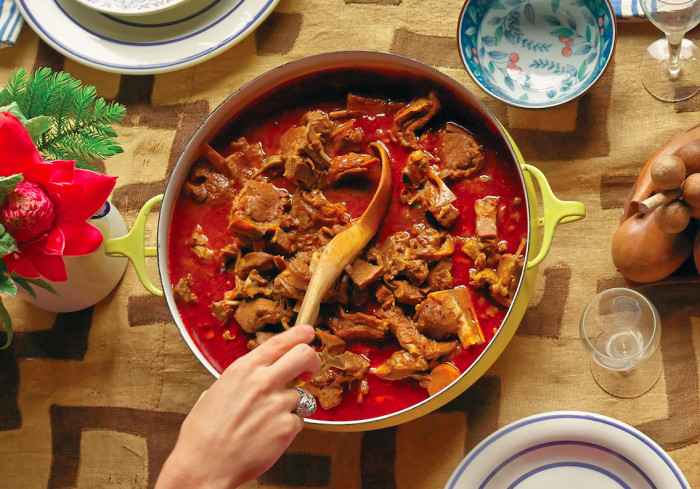Here's Why You Should Be Eating Goat Year-Round. Recipes Included.
Food Republic's column Ask Your Butcher seeks to answer FAQs in the world of butchery. Ethically minded butcher Bryan Mayer has opened butcher shops and restaurants and has trained butchers in the U.S. and abroad. He helped develop the renowned butcher-training program at Fleishers, where he is currently director of butchery education. In each column, Mayer tackles a pressing issue facing both meat buyers and home cooks. This week, he takes on a type of meat that he finds to be underutilized in U.S. kitchens.
October is firmly in our rearview mirror, or as some of the food-marketing folks like to call it, "Goatober." I'm here to tell you, however, that goat is something that can be enjoyed no matter what month it is. Whether you grill, braise or roast it, eating goat meat is something to be enjoyed year-round.
Goat is still a very small part of the meat industry in the U.S., but it has shown signs of growing over the past decade. The reason? Well, simply, goat meat is delicious. Sure, we are all very well aware of goats as a source of milk for dairy products or as fiber for their hides, but eating goat meat is something that we should all appreciate. The last few sentences alone should clue you in on how purposeful raising goats can be, as they can not only feed us but also keep us warm! And let's not forget that goat meat is consumed throughout the majority of the world.
Sure, goat suffers from a few negative connotations, not least of which is the phrase "old goat," but if you have been a reader of this column for any length of time, we champion the flavor of older, more mature animals. So is the old goat really that bad? I think not!
So let's talk a little about eating goat meat and dispel some myths along the way.
Eating Goat
The demand for goat meat in the U.S. is far greater than the supply. Our ever-increasing population of cultures that frequently eat goat meat is the main driver. However, despite the demand, producers in the U.S. face many challenges. Goats are seasonal breeders, and that poses problems in supplying the market with consistent, quality product. Coupled with the difficulty of obtaining goat meat through retail markets, it's more difficult for you, the consumer, to obtain goat outside of private channels, farmers' markets or on-farm sales. Goat just doesn't have the clout that other meats have...yet!
But what if I told you that goat meat is extremely nutritious, with high amounts of protein and iron? Okay, maybe now you're listening. And maybe lamb just isn't your thing and for some reason you're stuck on goat being too similar. Well, that's just not true. In fact, goat meat has a flavor profile that's more similar to beef. Not to talk down on lamb — you should totally eat lamb.
You've heard me talk about why you should eat veal. Well, you should be eating goat meat for the same reasons. They are incredibly sustainable, dual-purpose animals. The goat dairy industry generates a large number of kids (baby goats). Dairy farmers have no need for males and keep only some females. We need to put these surplus animals to use in the food chain. And it's not just about eating kid goat. Sure, we value tenderness and, of course, the lack of flavor that comes from such young animals, for some reason. But the full flavor of a mature goat can be just as rewarding as a culled dairy cow, mutton or sow. That means flavor, folks!
Okay, if I have to, I'll say it. You can cook goat much in the same way you cook lamb. There, does that make you feel more comfortable? Yes, you can have chops. Sure, you can roast a leg. And of course, you can braise it and even curry it if you want. The most important thing is that you're buying goat from a butcher or farmer that you trust, who has raised them out on pasture and allowed them to graze and forage and eat what they are supposed to eat!
So with that in mind, how about a recipe or two?
Let's skip the chops and go directly to my favorite parts, the legs and shoulders. And contrary to what you may think, roasting and braising are about the easiest ways to cook. Season, let sit overnight in your fridge, turn your oven on and let cook. You'll use a probe thermometer to make sure you get to the desired temp, and we'll spice minimally to make sure we don't mask that great goat taste.
Roasted Goat Leg
Ingredients
1 five- to seven-pound fully pastured, whole goat leg, bone in, aitchbone off
4 cloves of garlic
2 tablespoons salt
1 tablespoon paprika
1 teaspoon pepper
3 tablespoons lemon juice
½ cup olive oil
Directions:
Tip: Make sure your butcher ties your goat leg. This will give you a relatively even shape and help it cook more evenly. Or, if you're up for the challenge, watch our roast-tying video...
Braised Goat Shoulder
Ingredients
1 five- to seven-pound fully pastured goat shoulder, bone out
3 cups red wine (roughly the whole bottle, so get one for you to drink as well)
1 cup water
2 cups shallots, peeled
6 gloves garlic crushed/peeled
1 bay leaf
2 tablespoons salt
4 tablespoons vegetable oil
Directions:
Tip: Feel free to add any vegetables to your stew — potatoes, carrots, mushrooms, etc., making sure to account for variations in cooking time. We don't want the texture of mush!




